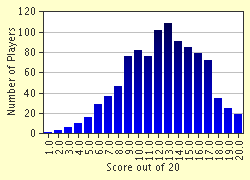Quiz Answer Key and Fun Facts
1. What resolution passed by the US Congress gave US President Lyndon Johnson the power to 'take all necessary steps, including the use of armed force,' in order to defend South Vietnam against Communist forces?
2. Who was the leader of the Soviet Union during the 1968 'Prague Spring'?
3. What was the nickname given by the American soldiers during the Vietnam War to the Vietcong?
4. Some months after Stalin's death in 1953, Malenkov emerged as the Soviet "supremo". In which order did his successors follow him?
5. Who were the Bay of Pigs invaders?
6. Winston Churchill made his famous 1946 'Iron Curtain' speech. In which US state?
7. Which Hungarian Prime Minister demanded that Hungary leave the Warsaw Pact and become a neutral nation, thus leading to the suppression of the 1956 Hungarian Uprising?
8. North Korea and South Korea are divided by which line?
9. When did the Soviet Union test its first atomic bomb?
10. Which of the following European countries did not belong to the Warsaw Pact when it was established?
11. In what year did the United States and the People's Republic of China establish formal diplomatic relations?
12. Which one of the following foreign policies was not part of the Cold War?
13. Who was the leader of the Solidarity Movement in Poland?
14. Which two leaders signed the SALT I Treaty in 1972?
15. Which two countries did not attend the 23rd Communist Party Congress in Moscow in 1965?
16. What do glasnost and perestroika mean?
17. Which European city was the symbol of the East-West divide in the Cold War?
18. The Truman Doctrine first helped which two countries against the threat of Communism?
19. What was the name of the all-out attack on South Vietnam cities by communist forces during the start of the Vietnamese New Year celebration?
20. When did the Soviet Union collapse?
Source: Author
Neurotic
This quiz was reviewed by FunTrivia editor
bloomsby before going online.
Any errors found in FunTrivia content are routinely corrected through our feedback system.

